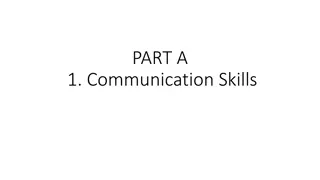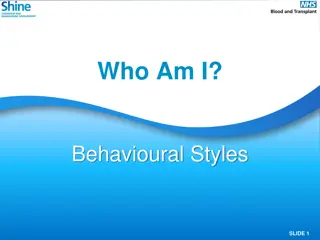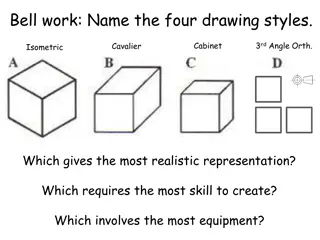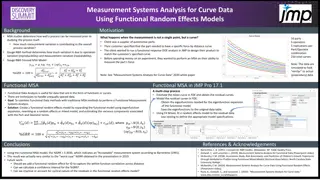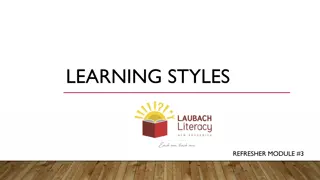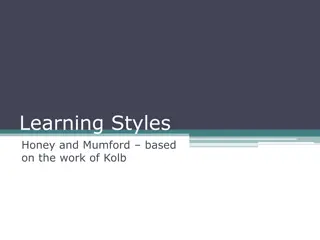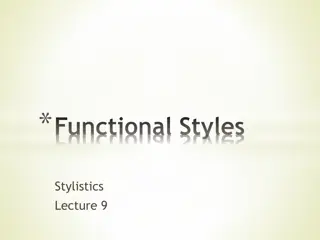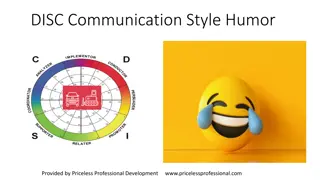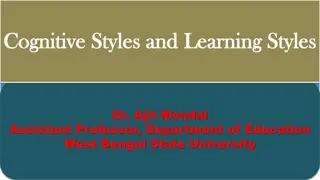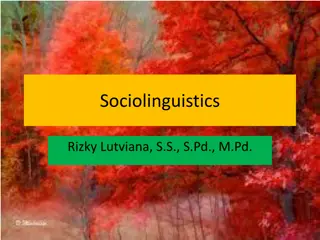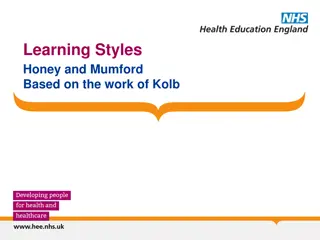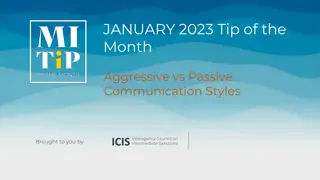Functional Styles in Language
The notion of style is explored in language use, including variations in literary and non-literary contexts, register linguistic features, and style-shifting according to formality. Definitions and classifications of style emphasize the distinctive features characteristic of register, genre, or authorial habits. Functional styles are seen as coordinated language means aimed at specific functions, primarily in literary standards. Different views on sublanguages and style specificity are also discussed.
Download Presentation

Please find below an Image/Link to download the presentation.
The content on the website is provided AS IS for your information and personal use only. It may not be sold, licensed, or shared on other websites without obtaining consent from the author.If you encounter any issues during the download, it is possible that the publisher has removed the file from their server.
You are allowed to download the files provided on this website for personal or commercial use, subject to the condition that they are used lawfully. All files are the property of their respective owners.
The content on the website is provided AS IS for your information and personal use only. It may not be sold, licensed, or shared on other websites without obtaining consent from the author.
E N D
Presentation Transcript
STYLE Lecture 2
The main notions Style variation in language use, whether literaryor non-literary. Register linguistic features common to particular non- literary situation e.g., language, sports commentary. those systemic variations in advertising, legal Style-shifting variation of style according to medium and degree of formality.
Definition Style a distinctive set or sum of linguistic features that seem to be characteristic of register, genre or period, etc. Author s style the set of features, peculiar to, or characteristic of an author, his or her language habits or idiolect. Each the same stock, but choice!
Choice in style Style in terms of choice: the selection of features partlydetermined by the demandsof genre, form, themes, etc. All utterances havea style, even if they might seem relatively plain of unmarked: a plain style is itself a style.
Definition of functional style Prof. V. Vinogradov s and I. Halperin s view: a functional style is a system of coordinated and interrelated, interconditioned language means intended to fulfill a specific function and aiming at a definite effect.
Functional styles are products of a certain concrete task set by the sender of the message. appear mainly in the literary standard of a language. Taken together all the FSs make up the entire system of language: each FS = neutral language means + specific elements.
Prof. Skrebnevsview: language contains an indefinite number of sublanguages, each subL. contains all the signs of language, but it servesa specific sphereof communication. Each subL. consists of units of 3 classes: absolutely specific units semi-specific units common (neutral) units (enter intoall sublanguages). FS is the sublanguage specificity all that is specific in a sublanguage belongs to style. 1. 2. 3.
The problem of classification Is the colloquial style a FS or does it belong tooral speech? Is therea specific poetic style? How many FSs are there in a language? Any classification -> simplification and is conventional and arbitrary.
Changes in FSs Each FS is a relatively stable system at a given stageof the development of the language. But it changes from one period to another, influenced by changing social conditions, the progress of science and culture, the development of language.
Classifications Prof. Budagov: the languageof science + the languageof emotive literature. 1. 2. Prof. Naer - 3 mega styles catering for: the sphere of communication; the sphereof masscommunication; the sphereof aestheticcommunication. professional and business 1. 2. 3.
The major universally accepted FSs: 1. The languageof belle-lettres The style of scientific prose: 4. the language of poetry the language of the humanities; language sciences; the language of emotive prose the of the exact the language of drama popular science prose. The style documents: language documents 2. The publicistic style of official 5. the language of oratory the language of essays the of diplomatic feature articles in newspapers 3. The newspaperstyle the language of legal documents language documents brief news items the of military newspaper headings notices and advertisements The colloquial style - ? 6.
The style of scientific prose Scientific prose proper Popular science prose
General characteristics The purpose to prove a hypothesis, to create new concepts, to disclose laws, to describe different phenomena => the language means of the style are objective, precise, unemotional and devoid of individuality. Generalized forms of expression, new words are often coined.
Lexical features the excessive use of terms; literary and neutral words mainly in their direct meanings; complete absence of standard colloquialisms, dialect, slang or vulgar words; comparatively limited vocabulary; smaller range of word-building patterns, selective use of pronouns (I we).
Terms - a word used in a branch of science in its direct referential meaning to name a certain scientific concept. Greek and Latin words and forms (datum data, formula formulae), abbreviations (TB), polysemanticwords avoided.
Syntactic features Structures prompted strictly by logical thinking: On the one hand, on the other hand Firstly , secondly The former , the latter Participial constructions before the modified word. Complex sentences prevail over compound sentences.
Trends within scientific prose science prose proper all of the above popular scientific prose the author has to bring his idea home, he uses comparisons with things known to the reader, metaphors which would illustrate his point, but: their function purely communicative.
Summary 1. The use of terms. 2. The absence of anycontextual meanings. 3. The logical sequence of utterances. 4. A developed and varied system of connectives to indicate the interrelation between sentences. 5. The use of quotations and references. 6. The frequent use of footnotes. 7. The impersonality of writing mainly revealed in the frequent use of passive constructions. 8. The frequent use of the following words: suppose, assume, presume, conclude, infer, point out, etc.
The belle-lettres style the languageof poetry the languageof emotiveprose the languageof drama
Function Halperin: the main function aesthetic-cognitive. The reader is made to see the writer s vision of the world, to participate in the act of creation, to experience the pleasure derived from the form.
Linguistic features 1. Genuine imagery achieved by linguistic stylistic devices. 2. The use of words in contextual meanings. 3. The individual choice of vocabulary reflects the author s personal evaluation of things. 4. A peculiar individual selection of syntax reflects the author s frame of mind. 5. The inclusion of elements from other styles, especially from the colloquial style.
The language of emotive prose changes from author to author; the imagery is not so rich as it is in poetry; combination of the literary variant of the language (both in words and syntax) with the colloquial variant; two forms of communication: monologue (the writer s speech) and dialogue (the speech of the characters).
The language of drama almost entirely dialogue, but stylized; the author s speech the playwright s remarks and stage directions. 16thcentury plays iambic pentameter, rhymed or unrhymed (dramatic poetry); late 18thcentury revival of drama: individualization of each character s speech , language a stylistic type of the spoken variety.
Characteristic features of drama 1) redundancy of information: the necessity to amplify the utterance for the sake of the audience; 2) the spoken language tends to curtail utterances, but not so extensive as it is in actual dialogues; 3) the monologue in plays is never interrupted; 4) a succession of questions (never in ordinary conversation); 5) the language of plays is already purposeful (the sequence of sentences reflects the sequence of thought and is directed by the playwright).
The language of poetry Classical poetry normative, it was regulated by rigid rules: common words were banished, special lofty, elevated vocabulary was prescribed; the pronouns of the 2ndperson singular (thou, thine, thyself).
The language of poetry Modern poetry nearer to colloquial speech, but traditions in the rhythmic and phonetic arrangement of the utterance: syntax and semantics comply with the restrictions imposed by the rhythmic pattern semantics: brevity of expression, epigram-like utterances and fresh unexpected imagery; syntax: elliptical, fragmentary sentences, detached constructions, inversion, asyndeton, etc.
Component patterns of rhythm 1) alternation of stressed and unstressed syllables; 2) equilinearity (equal number of syllables in each line); 3) a natural pause at the end of the line (the line a more or less complete semantic unit); 4) identity of stanza pattern; 5) established pattern of rhyming.
The language of poetry Modern versification sometimes deviates from these rules, free verse borders on prose. The most important feature of the poetic substyle its volume of emotional colouring. Emotiveness is compressed and substantial.

 undefined
undefined


 undefined
undefined



